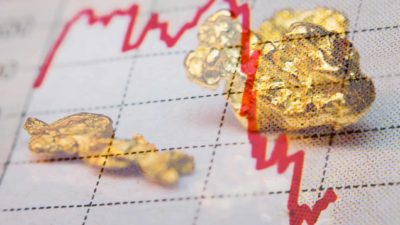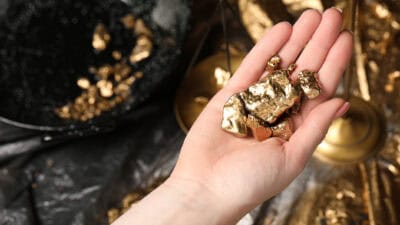The S&P/ASX 200 Index (ASX: XJO) is up 25% over the past 12 months and has gained 14% in 2021.
ASX 200 gold shares, however, have not contributed to that strong performance.
With a sliding gold price, it's been a difficult period for gold miners.
In fact, if you run your slide rule across the 32 gold shares listed on the All Ordinaries Index (ASX: XAO), you'll find that only 5 are in the black for the calendar year 2021. Meaning 27 are showing a loss.
This, while the All Ords index itself is up 14% year to date.
The S&P/ASX All Ordinaries Gold Index (ASX: XGD) tells a similar story. Over the past year, the All Ords Gold Index is down 27%. Year to date, it's lost 17%.
And the biggest producers, those topping the list of ASX 200 gold shares in terms of market caps, have not been spared.
How have these top ASX 200 gold shares been tracking?
Sticking with the 4 biggest gold producers by market cap:
- The Newcrest Mining Ltd (ASX: NCM) share price is down 26% over the past 12 months and down 6% in 2021
- The Northern Star Resources Ltd (ASX: NST) share price is down 34% over 12 months and down 30% year to date
- The AngloGold Ashanti CDI (ASX: AGG) share price is down 41% since this time last year and down 20% so far in 2021
- And the Evolution Mining Ltd (ASX: EVN) share price is down 31% over the past 12 months and down 25% year to date.
So, what's dragging on ASX 200 gold shares?
Miners are leveraged to the price of gold
While many factors impact the share prices of specific ASX 200 gold shares, the price of the yellow metal they dig up from the ground is a key factor.
And the gold price has been bouncing lower since hitting all-time highs of US$2,035 per troy ounce just over 1 year ago, on 7 August.
At the time of writing, an ounce of gold is worth US$1,755, down 14% from the August 2020 peak.
Now if you look at the share price losses for the ASX 200 gold shares listed above again, you'll notice all 4 have lost significantly more than 14% in 12 months.
Why is that?
Well, you may have heard it said that gold miners are leveraged to the price of gold.
That's because a miner's fixed costs generally don't change when the price of gold rises or falls.
Here's a quick, hypothetical example.
Say it costs a company $1,200 per ounce to recover gold and bring it to market. And say the current price of gold is $1,500. The company is therefore making a profit of $300 per ounce.
Now imagine the price of gold falls by $200 to $1,300 per ounce. The miner's profit margin is now down to $100 per ounce.
In our example, that's a 66% reduction in profit margins from only a 13% drop in the gold price. Hence, miners are said to be leveraged to the price of the minerals they produce.
As for our top 4 ASX 200 gold shares above, you can see they've all been impacted by falling gold prices. Some more than others.








